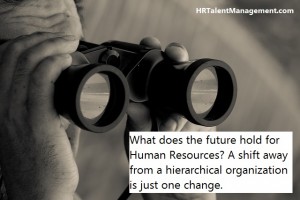 Nobody can dispute that the landscape of the workplace has been shifting and changing, but what might our workplaces look like in five years? What changes can we expect to see coming about by 2020? According to Dr. Di Ann Sanchez, a leading voice in organizational management and human resources strategies, we should expect to see “flatter” organizations.
Nobody can dispute that the landscape of the workplace has been shifting and changing, but what might our workplaces look like in five years? What changes can we expect to see coming about by 2020? According to Dr. Di Ann Sanchez, a leading voice in organizational management and human resources strategies, we should expect to see “flatter” organizations.
“I don’t think this whole concept of ‘me manager, you employee,’ is going to work,” Sanchez says. The manager of 2020 will no longer truly be a manager, and Dr. Sanchez believes that the term “management” should actually go away. Instead of a hierarchical organization, Sanchez believes that corporations and companies will shift dynamically into spiderwebs of interconnected employees, coaches/leaders, and mentors.
Sanchez points out that Zappos has already eliminated their management structure, shifting to team-based units that get the work done. “The jury is still out on how well that’s going to work,” Sanchez says, but the early results are positive. The new approach, called holacracy, is designed to help Zappos function more like a city than a bureaucratic corporation. The holacracy system is based on research which shows that every time the size of a city doubles, the innovation or productivity of each resident increases by 15%; however, such innovation or productivity per employee actually goes down when the size of the corporation or company doubles.
“Millennials will be more than 50% of the global workforce by 2020,” Sanchez states. The generation will demand that hierarchies go away in favor of flatter organizational structures that allow employees to choose who they turn to as mentors and, to some degree, coaches or leaders.
She expects that we will see various coaches or leaders for different aspects of jobs, such as leaders for the marketing aspect of a position and those for the technical development role in a position. But that’s not all that Sanchez expects to see changing.
“[Employees] are going to do their shopping around by doing this freelance stuff as portfolio employees, based on projects,” Sanchez predicts. Rather than employees working for single employers full-time or permanently, workers will freelance and work on a project basis. “We’re going to have these portfolio or project-based employees that want to get their teeth into something they’re passionate about as well as working for a company they’re passionate about,” Sanchez states.
What does this mean for Human Resources professionals? In part, it means that the “one size fits all” mentality needs to shift, as HR departments look for new strategies to attract and retain talent. On top of that, Sanchez says that “the whole branding of the company needs to show social responsibility, giving back to the Earth, doing community service, et cetera.” Employers will also need to look at improving flexibility in the workplace, redefining what an employee is and what the workplace looks like.
Current market statistics show that in five years, Generation Y employees will make up 49% of the workforce, with Baby Boomers only constituting 15% of the workforce and Generation X employees rounding out approximately 32%. “The next ten years are going to be very, very much about change,” Sanchez says. HR departments and employers as a whole need to be thinking about how to redefine the workplace to attract the best and the brightest talent, and that may mean completely rethinking the whole concept of “employee” versus “contractor” or “freelancer.”
